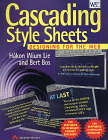A Definitive Guide to Cascading Style Sheets
Good coverage from the authors of the original specification, clear, concise, matter of fact, and full of examples.
ORIGINAL DRAFT
Cascading Style Sheets (CSS) are a big part of the Word Wide Web, but sometimes misunderstood. Whether you’re an expert looking for a refresher or a reference, or just looking to understand what Cascading Style Sheets are all about, this is a book that’ll give you the scoop. Written by the authors of the CSS specification, "Cascading Style Sheets, Designing for the Web" is a definitive source. Harkon Lie and Bert Bos were part of the CERN group in Geneva that was responsible for the World Wide Web. Most of us know the folklore about CERN’s central role in the web, so I won’t boor you with a refresher. Suffice it to say, the information in this book comes from the Web cradle and reflects CSS origin and design criteria better than almost any other book on the subject.
The book is divided into 15 chapters and a couple of appendices. The progression of information is well designed. The CSS specification was developed to provide a vendor-neutral solution to separating content matter from stylistic information. With style sheets, you can define the look of a document without impacting its message, allowing you to change styles with ease and control styles across multiple documents from a single source.
Chapters 1 and 2 review the fundamentals of HTML and discuss how CSS fits into the Web publishing model, after which the authors dive into the mechanics of CSS elements. Chapter 3 covers selectors, fonts are covered in Chapter 4, basic structures in Chapter 5 and spacing in Chapter 6. Each of these provides a clear, accessible explanation of the topic matter being covered. Chapter 7 hits images and Chapter 8 covers colors. Each chapter looks at the various style markup elements in the CSS language and talks about their purpose, arguments and where they might apply. The examples are well designed and really help clarify the concepts as they are presented.
Chapters 9 and 10 cover examples of web pages that demonstrate various real-world applications of CSS. Chapter 11 takes a look at inheritance. CSS, as the name implies, allows for a cascading effect when multiple style sheets are nested. There are also implications within the document hierarchy. Chapter 12 talks about how large collections of documents can be managed with CSS and what the organizational issues might be. Chapter 13 provides a set of useful guidelines for style sheet design. Chapter 14 covers alternative approaches and Chapter 15 looks ahead at the future.
A lot of web designers limit themselves to a lowest common denominator approach. CSS has been around for a while now and is supported on the most widely used browsers. It makes little sense to couple Web content with stylistic design, given that changing the design requires so much work, making the prospect prohibitive and unlikely to happen without problems. CSS helps solve the problem by uncoupling the style from the document matter. "Cascading Style Sheets, Designing for the Web" provides both coverage and insights into the original design that is unavailable elsewhere. A good investment for any active web designer.
